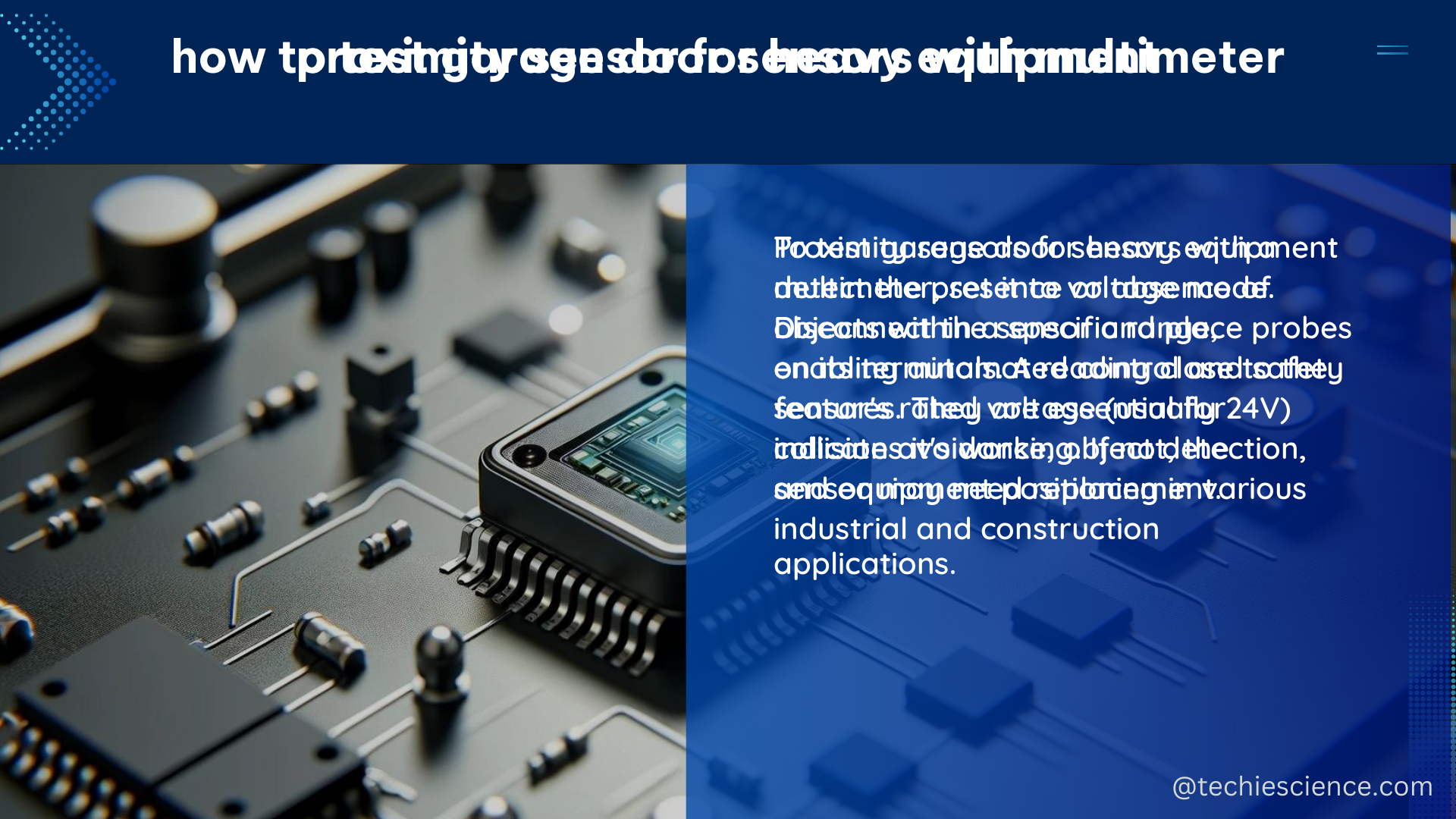Proximity sensors are essential components in the world of heavy equipment, ensuring safety, efficiency, and productivity. These sensors are designed to detect the presence or absence of objects within a specific range, making them invaluable for applications where maintaining a safe distance or automating tasks is crucial.
Understanding Proximity Sensors for Heavy Equipment
Proximity sensors in heavy equipment serve a variety of applications, including collision avoidance, load monitoring, and equipment maintenance. These sensors can detect the presence of nearby workers or other equipment, preventing accidents and ensuring compliance with safety regulations. They can also monitor the load on cranes, excavators, and other heavy machinery, preventing overloading and damage to the equipment. Additionally, proximity sensors can detect equipment malfunctions or wear, enabling predictive maintenance and reducing downtime.
Technical Specifications
When selecting proximity sensors for heavy equipment, several key factors must be considered:
-
Sensor Range: The distance at which the sensor can detect objects is a crucial factor. Proximity sensors for heavy equipment can have a range from a few inches to several feet, depending on the specific model and application.
-
Sensor Accuracy: Accuracy is measured in terms of the sensor’s resolution, which is the smallest change in distance that the sensor can detect. For example, a sensor with a resolution of 1 mm can detect changes in distance as small as 1 mm.
-
Response Time: The sensor’s response time determines how quickly it can detect changes in distance, which is essential for applications that require rapid reaction times.
-
Environmental Specifications: Proximity sensors for heavy equipment must be able to operate in various environmental conditions, such as temperature, humidity, and vibration, without compromising their performance.
-
Power Consumption: The sensor’s power consumption is an important factor, especially for battery-powered or remote applications.
-
Communication Protocols: Compatibility with common communication protocols, such as CAN bus, Modbus, and Profibus, is crucial for integration with existing control systems.
Sensor Types
Proximity sensors for heavy equipment can be categorized into several types, each with its own advantages and applications:
-
Inductive Proximity Sensors: These sensors use an electromagnetic field to detect the presence of metallic objects, making them suitable for applications involving metal targets.
-
Capacitive Proximity Sensors: Capacitive sensors can detect the presence of both metallic and non-metallic objects, making them versatile for a wide range of applications.
-
Ultrasonic Proximity Sensors: Ultrasonic sensors use sound waves to detect the presence and distance of objects, and are effective in environments with poor visibility or where other sensor types may not perform well.
-
Photoelectric Proximity Sensors: These sensors use light-based detection, making them suitable for applications where the target object may not be metallic or have a consistent surface.
Sensor Mounting and Integration
Proper mounting and integration of proximity sensors in heavy equipment is crucial for their effective operation. Factors to consider include:
-
Sensor Placement: The location of the sensor must be carefully chosen to ensure optimal detection range and coverage, while also considering potential interference from other equipment or environmental factors.
-
Mounting Techniques: Proximity sensors can be mounted using various methods, such as flush mounting, surface mounting, or bracket mounting, depending on the specific application and equipment design.
-
Wiring and Connectivity: Ensuring reliable wiring and connectivity between the proximity sensor and the control system is essential for data transmission and system integration.
-
Calibration and Adjustment: Proper calibration and adjustment of the proximity sensor’s parameters, such as sensitivity and detection range, are necessary to ensure accurate and reliable performance.
Maintenance and Troubleshooting
Maintaining and troubleshooting proximity sensors in heavy equipment is crucial for their long-term reliability and performance. Key considerations include:
-
Sensor Cleaning: Regular cleaning of the sensor’s surface to remove any dirt, debris, or buildup that could interfere with its operation.
-
Sensor Inspection: Periodic visual inspection of the sensor and its mounting to identify any physical damage or wear that may affect its performance.
-
Diagnostic Testing: Performing diagnostic tests, such as checking the sensor’s output signals or verifying its response to test objects, to identify and address any issues.
-
Firmware Updates: Ensuring that the sensor’s firmware is up-to-date, as manufacturers may release updates to improve performance or address known issues.
-
Replacement and Upgrades: Replacing aging or malfunctioning sensors with newer, more advanced models can improve the overall performance and reliability of the heavy equipment.
By understanding the technical specifications, sensor types, mounting and integration, and maintenance requirements of proximity sensors for heavy equipment, operators and maintenance personnel can ensure the safe, efficient, and productive operation of their machinery.
Reference:

- Proximity Sensors for Industrial Automation: A Comprehensive Guide
- Understanding Proximity Sensor Technology
- Proximity Sensor Selection Guide

The lambdageeks.com Core SME Team is a group of experienced subject matter experts from diverse scientific and technical fields including Physics, Chemistry, Technology,Electronics & Electrical Engineering, Automotive, Mechanical Engineering. Our team collaborates to create high-quality, well-researched articles on a wide range of science and technology topics for the lambdageeks.com website.
All Our Senior SME are having more than 7 Years of experience in the respective fields . They are either Working Industry Professionals or assocaited With different Universities. Refer Our Authors Page to get to know About our Core SMEs.